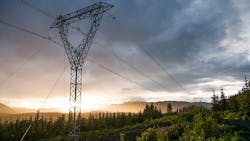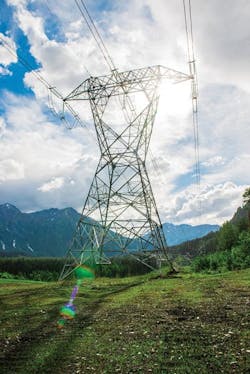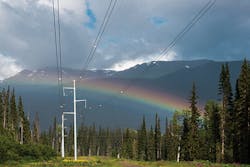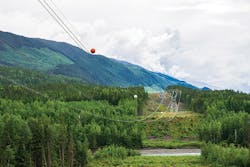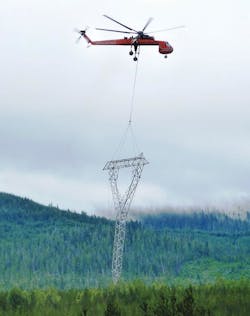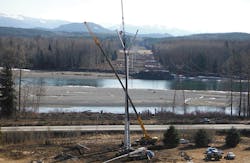BC Hydro Delivers Power and Progress
Northwest British Columbia is one of the most remote and beautiful corners of North America. Rich in mineral and natural resources, the province until recently was hampered in realizing the region’s full economic potential, largely because of unreliable power sources and interconnections. The British Columbia government answered that challenge when it directed provincial Crown Corporation BC Hydro with the task of constructing a transmission line to serve the northwestern area of the province.
The Northwest Transmission Line (NTL) project called for erecting a 344-km (213-mile), 287-kV power line from the town of Terrace on the south to a new substation in the north near Bob Quinn Lake, in the heart of mining country. The potential economic payoff was huge. By providing an interconnection point to the BC Hydro grid, the NTL helped jump-start potential mining ventures in an area rich with gold, silver, nickel, zinc and other high-value metals and minerals. The total estimated value of these projects alone is US$18 billion, and includes up to 5500 direct jobs and an additional 18,000 indirect jobs. In addition, the NTL will provide a secure interconnection point for several renewable run-of-river hydro facilities in the area. Another benefit is the possibility of connecting some of the area’s isolated communities that currently rely on diesel generators
to the BC Hydro grid and a source of clean electricity.
Construction work on this massive project began in January 2012. A little more than two years later, in July 2014, the NTL came into service.
Engineering and Construction Challenges
Described as BC Hydro’s biggest project in several decades, the NTL was a unique engineering and construction challenge. The utility identified Burns & McDonnell as an industry leader in mega-project delivery because of its experience working on large projects in challenging environments and rugged terrain. Burns & McDonnell supported Southern California Edison’s Tehachapi Renewable Transmission Project (TRTP), which included similar challenging terrain and environmentally sensitive areas. TRTP segments 1 and 3 crossed through miles of mountainous terrain in the Angeles National Forest and included numerous areas accessible to crews only by helicopter drop zones, followed by hikes up narrow mountain trails. Much of the NTL route in British Columbia would present similar challenges for the transport of crews, equipment and materials.
To pursue and deliver the NTL project, Burns & McDonnell teamed with Valard Construction of Edmonton, Alberta, Canada, to form Valard–Burns & McDonnell, a British Columbia corporation. After a substantial proposal development effort, the team was awarded the project over three competitors in August 2011.
Terrace, the starting point of the project, is a 1355-km (840-mile) drive on mostly two-lane highways from Vancouver, the principal port, population center and business hub of British Columbia. From Terrace to Bob Quinn, most of the route of the NTL follows a river valley, flanked by mountains, and runs parallel to Highway 37, the only major roadway serving northwest British Columbia. In most sections of the route, work camps were required to lodge construction crews because the area is so thinly populated.
The system had to be designed to span major river crossings at the Skeena and Bell rivers as well as a narrow section of Nisga’a Memorial Lava Bed Provincial Park. The spans between transmission towers ranged from 95 m to 1090 m (312 ft to 3576 ft) in areas requiring waterway and wetland crossings.
Construction Conditions
BC Hydro selected the Valard–Burns & McDonnell team for the assurance that engineer-procure-construct (EPC) project delivery would provide single-point responsibility for design and construction, as well as schedule and cost commitments. The project was planned to accommodate unexpected challenges from weather and other contingencies. For example, portions of the transmission line had to be built through geologically unstable areas prone to rockslides or seismically active areas with liquefiable soils. Other areas were vulnerable to avalanches caused by winter snowfall accumulations that sometimes reach more than 20 m (66 ft).
To accommodate these conditions as well as steeply angled slopes and other challenges, project engineers chose a guyed Y tower design, which features a relatively small single-point tower mast stabilized on four corners by steel guy wires attached to buried precast concrete anchor pads. Because of its relatively small footprint and ability to be constructed by helicopter lift, the tower design was especially helpful in meeting environmental permit requirements for portions of the project traveling through sensitive areas.
The tower design still had to be tough enough to withstand potential impacts from powerful avalanches and avalanche-driven winds packing a combined wallop of up to 48-kPa (1000 lb/sq ft) on towers located in or near avalanche chutes. The engineering features in avalanche zones also include conductor hardware designed to break away at a certain impact or wind force to maintain structural integrity of the towers. Replacing the conductor and restoring service can be done in two to three hours versus taking several days, or longer, to rebuild an entire tower.
In other areas, larger tower members were used to reinforce tower bases, or diversion berms were designed to divert avalanches or rockslides away from the structures.
On many days, construction was hampered by fog, mist or rain. During the winter, sunlight was available for only about six hours a day in the northern latitudes. Temperatures also dropped as low as -45°C (-50°F) in the higher elevations, and crews spent many days clearing heavy snow from equipment and materials before they could begin assembly or installation. And during the first winter of construction, the main highway was blocked for several days by a major rockslide.
Equipment and materials were sourced from as far away as India, Italy and South Korea, which required close coordination and scheduling to arrive at the times needed. Lattice steel towers, conductor, fiber-optic cable and manufactured hardware all were shipped to Terrace, then trucked to construction laydown sites strategically located along the route. Products delivered from overseas manufacturers were shipped on large cargo ships to the Port of Prince Rupert, unloaded and trucked to Terrace.
Hundreds of steel tower components were assembled at fly yards located near construction zones. When fully assembled, the towers were picked up by heavy-lift helicopters and flown into place, where crews would set the structures on buried grillage foundations before securing the four guy wires to the concrete anchors.
The project required approximately 1000 guyed-Y tower structures and an additional 100 towers that were either conventional self-supporting lattice steel towers or self-supporting tubular steel monopoles.
Helicopter construction generally was scheduled during milder weather periods. On exceptionally busy days with favorable conditions, helicopters could install up to 35 of the 9-tonne (10-ton) transmission towers each day. The average was about 20 towers installed daily.
Environment and Cultural Issues
Environmental concerns ranged from avoiding the migratory routes of tiny toads the size of a fingernail to protecting grizzly bear dens. Helicopters also were prohibited from flying over certain zones during mountain goat breeding seasons.
Sensitive wetlands bordering rivers and streams beyond the immediate vicinity of construction were protected, too. Those areas, called riparian zones, are important wildlife habitats and protected to reduce erosion and maintain water quality, particularly important in fish-bearing streams critical to the region.
The project also was very culturally sensitive because it crossed the traditional territories of eight First Nations as well as the sovereign land of Nisga’a Nation. First Nations and Nisga’a Nation were contracted to perform the clearing and building of construction access roads. Many First Nations also were hired during later construction phases, for which they were trained to perform a variety of tasks. Representatives of the First Nations and Nisga’a Nation frequently visited The Northwest construction zones to monitor compliance with permitting agreements.
Coordinated Efforts
The detailed design of the project commenced in August 2011. Lattice tower load testing occurred in early 2012 with bulk lattice tower deliveries starting in mid-2012. Valard–Burns & McDonnell began construction in May 2012, starting with grillage foundation and guy anchor installation. BC Hydro was responsible for right-of-way clearing as well as improving and building access roads to the construction sites, many of them former logging trails. Clearing and access road construction started in early 2012 in advance of Valard–Burns & McDonnell’s mobilization to the site.
Valard–Burns & McDonnell was responsible for the design and construction work, ultimately employing hundreds of employees at the job site in British Columbia and in headquarter locations. Burns & McDonnell assigned about a dozen employees to field locations and another 15 were dedicated to the project at the firm’s headquarters in Kansas City, Missouri, U.S.
Paying Dividend
The NTL project already has stimulated substantial investment in the northern tier of British Columbia. AltaGas, an independent power producer in Alberta, has commissioned the $700 million Forrest Kerr project 40 km (25 miles) west of Bob Quinn to sell power to BC Hydro. As the anchor tenant for the NTL, AltaGas contributed to the project’s capital costs. Also, Imperial Metals Inc. is building a 90-km (56-mile) transmission line extension to bring power to its Red Chris copper and gold mine project valued at $500 million. The mine is scheduled to start operations in early 2015.
Capitalizing on the NTL and the line built by Imperial Metals, BC Hydro expects to interconnect the community of Iskut to the grid later this year. The utility estimates that supplying Iskut from the grid will reduce greenhouse-gas emissions by about 2800 tonnes (3086 tons) per year.
Jim Shepherd ([email protected]) is a project manager for BC Hydro. He has more than 20 years of experience working on a wide range of projects including transmission lines, generating stations, and chemical and smelting facilities. He is a registered professional engineer in the province of British Columbia.
Andy Jarvis ([email protected]) is vice president and director of transmission and distribution EPC projects for Burns & McDonnell. He has 20 years of experience working on a wide range of transmission line and substation projects, including serving as project manager on several EPC projects. He is a registered professional engineer in several U.S. states and Canadian provinces.
Todd Hunt ([email protected]) is a project manager for the Burns & McDonnell construction/design-build division, where he oversees all phases of major EPC transmission line and substation construction projects. With more than 20 years of experience in project management, project controls and construction/design management, Hunt has managed many of Burns & McDonnell’s mega-scale projects.
Mentioned in this article:
AltaGas | www.altagas.ca
BC Hydro | www.bchydro.com
Burns & McDonnell | www.burnsmcd.com
Imperial Metals | www.imperialmetals.com
Southern California Edison | www.sce.com
Valard Construction | www.valard.com
